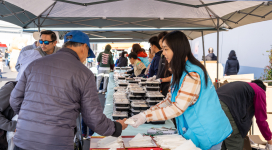
A jarring document released earlier this week reveals that the ferry Sewol had exceeded its cargo limit on 246 trips in the 13 months prior to its sinking, allowing hundreds of passengers to voyage on an unsafe vessel.
According to Fox News, the document states that one private, industry-connected entity recorded the weights, and another set the weight limit. However, the two entities never communicated, affecting in part the April 16 sinking of the boat, leaving nearly 300 passengers missing or dead.
The tragedy has shaken South Korea, exposing shocking safety violations conducted by South Korea's domestic ship supervisors. There was sufficient information recorded for the ship's regulators to conclude that the Sewol was regularly overloaded; however, because the government did not require them to share the data, it was essentially useless, TIME reports.
While the cause of the sinking is still being investigated, experts believe that if the ship held too many passengers, even the slightest turn could cause it to tip over. Tracking data reveals that the Sewol made a 45-degree turn around at the same time it began sinking, and several crew members reported that they believe something went wrong with the steering as they attempted a smaller turn.
"It seems that all they cared about at Chonghaejin Marine is the volume of the cargo and not the actual weight, because the company charges by volume," prosecutor Yang Joong Jin said in an interview with Bloomberg.
The ferry operator "was trying to make a profit by overloading cargos," said Kim Gil-soo, a professor at Korea Maritime and Ocean University in Busan, "and public agencies that should have monitored did not monitor that."
Individuals involved in the tragedy have come under intense fire. South Korean President Park Geun-hye has vowed to "punish those responsible" for the tragedy; thus far, all 15 surviving crew members have reportedly been arrested, accused of negligence and failing to protect passengers. Heads of the shipping association and the register offered to resign following the tragedy, and even the South Korean Prime Minister left office due to the ordeal.
However, TIME reports that an official with the Korea Shipping Association's safety team said it is beyond the association's capacity to determine whether a ship is carrying too much cargo.
"What we can do is to see the load line is not submerged," he said. "The only person on any vessel who knows the exact cargo safety limit, excluding ballast water, fuel, passengers and others, is the first mate."
Lee Joon Suk, the captain of the ship, has apologized for the mistake.
"I am really sorry and deeply ashamed," he said. "I don't know what to say."
Yet no words are able to comfort the grieving friends and family members of the dead passengers.
"The rescue wasn't done well. We were wearing life jackets. We had time," passenger Koo Bon-hee said from a hospital bed in Mokpo. "If people had jumped into the water ... they could have been rescued. But we were told not to go out."
Captain Bill Doherty, Nexus' Director of Maritime Affairs, stated that a series of errors led to the disasters, beginning with the ship's overload of passengers.
"In my opinion, it appears that the sinking of the MV Sewol and the tragic loss of lives was a preventable, final link in a systemic fatal chain of errors, possibly dating back months, when the Sewol was retrofitted with additional passenger facilities on the upper decks, raising the ship's center of gravity," Captain Doherty explains. "With a recent report that the Sewol had a 36-second power loss just prior to tipping, one has to ask the fitness of this ship to be sailing."







